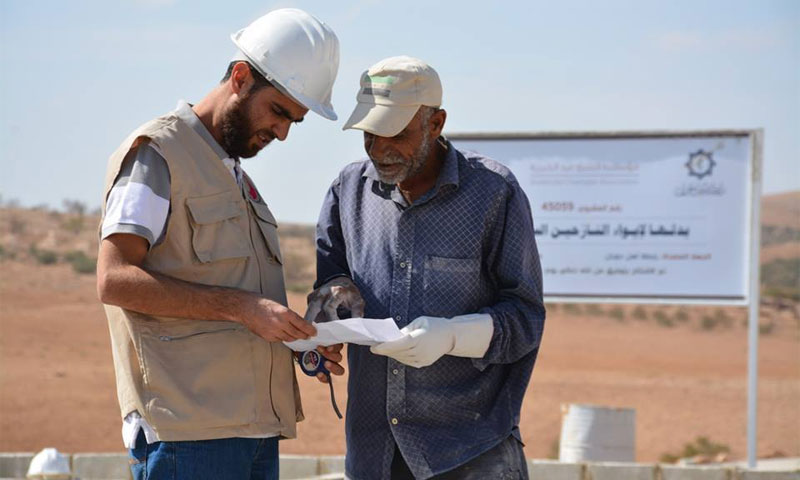



Enab Baladi – Deraa
Some of the camps in southern Syria are three or four years old, and with the continuation of the revolution and the continued escalation by regime forces, the number of camps and camp residents are on the rise. In the absence of any solutions for rebuilding, it has become vital to search for radical projects to alleviate the reoccurring winter suffering. Baladha construction project is one of these solutions, rising to prominence with its aim of building 80 residential units for 500 residents of the camps and fields.
The efforts by humanitarian and aid organizations to prepare for the winter season in southern Syria hastily continue as these organizations work to alleviate the suffering of camp residents by providing aid and rehabilitating camps and roads leading to the camps. However, these efforts continuously clash with the realities on the ground in terms of camp conditions and the high number of camp residents, which call for radical alternatives and permanent solutions.
The project overseen by the Ahl al-Hawran Association in coordination with Eid charity organization is considered the first solution to the tragedy of the camps in southern Syria.
Osama al-Najjar, Ahl al-Hawran Association’s media manager, spoke to Enab Baladi explaining that the association has prepared for the winter season in order to reduce the severity of its impact on those affected. He said, “We made a preemptive move by starting to prepare residential units. A single unit is 53 square feet and includes two rooms and is big enough to house a family of six.”
Al-Najjar clarified that the residential units will be equipped with water and sewage pipes, “But in its first phase, the project will not equip the interior of the residential units in terms of furniture and other thingss. There are future projects to distribute heaters, heating materials and blankets in addition to winter clothing.” These emergency projects are added to the general projects for wheat and food distribution, the mobile clinics, and “a long list of other camp projects.” The association prepares studies and programs, which it presents to funders and organizations for them to execute the projects. The winter projects are the association’s priority at the moment, according to al-Najjar.
The limited number of residential units and the high number of camps raises the question of who will take priority in benefiting from this project. Al-Najjar explained that the association has placed the “Middle Sector” camps, which include the camps and residences of Zayzun in addition to the Amal, Jbata and al-Barqiyeh camps in al-Qunietra, as the top priority. “After these camps come the groups who fled the bombing in areas of intense fighting, persons residing in camps at the edges of villages and towns and in schools, in addition to poor families.”
The aid team in the association conducted a preliminary survey whose results revealed the presence of over 10,000 families eligible to benefit from this project, according to al-Najjar. He said, “The number may increase or decrease according to the security situation. We are working in coordination and cooperation with the local councils in the areas that our projects target, and so the councils will be responsible for establishing the mechanisms and criteria for settling the displaced persons according to the priorities set.”
Al-Najar explained that the move towards developing construction projects does not mean that the phase of reconstruction in Syria has begun. “These projects are included in the framework of emergency plans to reduce the suffering of those forcefully displaced from their homes.” In its studies, the association accounted for potential dangers such as the probability the regime will bomb these residential units, “We built in some measures to reduce the effect of regime bombing.”
Fear of the regime’s repeated attacks is one of many of the challenges facing the project. Another major challenge is the rise in the price of building materials that enter the liberated areas from regime-controlled areas. Al- Najjar said, “We can overcome the rise in prices by increasing the initial cost of the project but the major problem – to which we currently have no solution – is the large number of migrants and displaced persons in most of the southern Syrian areas… The residential units cannot absorb all those displaced, and we must not forget that the regime bombing continues and the constant fear forces many people to repeatedly leave their homes.”
It appears that waiting for the resolution of the “Syrian Crisis” is no longer appealing to camp residents and with the arrival of winter each year the sense of fear of the approaching suffering increases. It is now mandatory for authorities and relief bodies to focus on finding radical solutions that will put an end to the suffering of camp residents. Meanwhile, camp residents are asking themselves whether substituting a tent with a temporary shelter is the first step towards establishing permanent camps as an alternative to their original homes. Are we today in the middle of repeating the experience of Palestinian refugee camps and the Golan Heights refugee camps? The answer will be in what the revolution delivers in the coming days.
if you think the article contain wrong information or you have additional details Send Correction